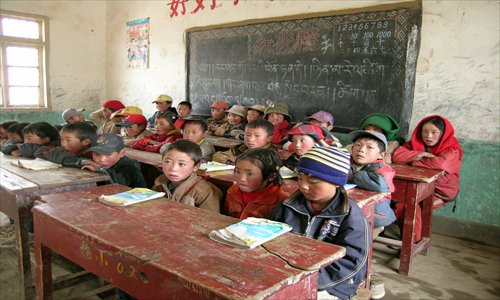Disappearing classrooms

Wang Lei, an independent documentary film director, posted a series of photos on Sina Weibo of his abandoned village primary school in rural Hunan Province.
One of the pictures showed the last words that were etched on the cracked classroom blackboard.
"Please take care."
For Wang, this place was more than just a school. "My grandfather, my father, my brother and I all graduated from this school. Now the school is gone, I feel like some of the village traditions have been buried with it too," Wang told the Global Times.
Abandoned schools are becoming a more common sight in rural China. Between 2000 and 2010, 63 primary schools, 30 teaching stations (smaller schools) and three secondary schools disappeared in rural areas every day, said a report by the 21st Century Education Research Institute, a non-governmental organization (NGO) focusing on China's public education system.
The vast disappearance of rural schools was triggered by a government strategy in 2000 to remove village schools and consolidate education resources in counties and townships.
Some 229,400 primary schools, 111,000 teaching stations and 10,600 secondary schools have been abandoned over the past 10 years. These shocking figures include half the country's rural primary schools, 60 percent of the teaching stations and over one quarter of the secondary schools.
At the same time, the number of students in the countryside has been decreasing. Over a third of the primary school students and over a quarter of secondary school students have left.
"Some of them have dropped out of schools altogether but a majority of them now receive their education in townships," said Yang Dongping, director of the 21st Century Education Research Institute.
The missing heart of the village
Wang said this school used to be a crucial part of the social dynamics of the village. Whenever there was a wedding or a funeral, the teachers were invited. They were highly respected.
The dynamics have quietly changed. Many have left, those who are left often just spend their days gambling. Children have been left behind by their parents year after year. The influx of migrants into cities has hollowed out much of the countryside.
Cheng Hongbo, a deputy principal of Xifeng primary school in rural Henan Province, tells of how a student once mocked teachers by asking "what is the use of studying, seeing as my undereducated parents make more money than countryside teachers?"
Wang sees it all as part of a bigger problem.
"The fundamental teachings of the Chinese culture, the very concept of right and wrong, the core values of a society, once held together by village schools, are now lost," Wang said. "These schools are not just about children. They are the center of a community and in turn help build a stable society."
Centralized schools
"There are advantages to the strategy of consolidating education resources in rural areas," Cheng told the Global Times. "After the consolidation process, we now have a more stable source of students and more available teachers."
The disadvantage, he said, is the inconvenience caused to his students due to the long distances. In some cases, students have to walk an hour and half to get to school every day.
"The consolidation plan has put a great financial burden on the parents since children now have to eat and live away from home or pay for their daily commute," said Tong Xiaoxi, deputy secretary general of the Zigen China for Rural Education and Development.
With many parents in rural China relocating for their children's education and mothers and fathers living apart, the divorce rate has also risen.
"Education should be a comprehensive process which includes the cultivation of personalities, interaction with communities and quality time with family. Consolidating these schools damages these, and is an unfortunate result of China's exam-oriented education system," said Tong.
The plan was halted in 2012 after more problems with the strategy were revealed, including a car crash in November 2011 in which 19 children were killed in a school bus on their way to a consolidated kindergarten in rural Gansu Province.
"The plan was designed with good intentions but in reality was driven by economics," said Tong. "Some local governments intentionally shut down village schools so they could amass students in townships and force their families to spend. The plan has become a tool for local governments to boost tax income and drive up GDP."
A lost decade
This consolidation has coincided with a steady rise in the country's overall primary school dropout rate to the level it was at a decade ago, said Han Qinglin, an official from the Hebei provincial department of education, as well as the chairman of the Association of Rural Education under the Chinese Society of Education.
There were 633,000 primary school dropouts across the country in 2008, accounting for 0.599 percent of the overall students, however, these figures surged to 883,000 and 0.88 percent respectively in 2011.
"The 0.88 percent rate was on a par with the average level from 1997 to 1999, especially when the country exempted all tuition fees for the nine-year compulsory education program covering primary and junior high schools," Han added, also pointing out that there would be frightening implications, including another million illiterate students.
The dropout students have also become younger. Previously they dropped out in higher grades, but from 2007 to 2009, low grade dropouts accounted for nearly 80 percent of dropouts, the highest level ever in Chinese history.
Yang Dongping called for officials to consider the numbers of students and the ramifications of the one-child policy.
"The scale of the removal and restructuring of the teaching network in rural areas has far outpaced demographic changes. During the past 10 years the number of students has dropped by 37 percent, however, the number of school has been slashed by 52 percent," he said.